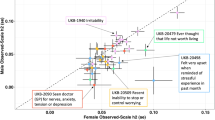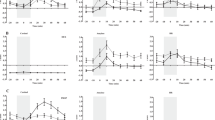Abstract
Although few studies dispute that there are gender differences in depression, the etiology is still unknown. In this review, we cover a number of proposed factors and the evidences for and against these factors that may account for gender differences in depression. These include the possible role of estrogens at puberty, differences in exposure to childhood trauma, differences in stress perception between men and women and the biological differences in stress response. None of these factors seem to explain gender differences in depression. Finally, we do know that when depressed, women show greater hypothalamic–pituitary–adrenal (HPA) axis activation than men and that menopause with loss of estrogens show the greatest HPA axis dysregulation. It may be the constantly changing steroid milieu that contributes to these phenomena and vulnerability to depression.
This is a preview of subscription content, access via your institution
Access options
Subscribe to this journal
Receive 12 print issues and online access
$259.00 per year
only $21.58 per issue
Buy this article
- Purchase on Springer Link
- Instant access to full article PDF
Prices may be subject to local taxes which are calculated during checkout
Similar content being viewed by others
References
Kendler KS, Kessler RC, Walters EE, MacLean C, Neale MC, Heath AC et al. Stressful life events, genetic liability and onset of an episode of major depression in women. Am J Psychiatry 1995; 152: 833–842.
Brown GW, Harris T . Social Origins of Depression: A Study of Psychiatric Disorder in Women. Free Press: New York, 1978.
Frank E, Anderson B, Reynolds C, Ritenour A, Kupfer DJ . Life events and the research diagnostic criteria endogenous subtype: a confirmation of the distinction using the Bedford College methods. Arch Gen Psychiatry 1994; 51: 519–524.
Nolen-Hoeksema S . Sex differences in unipolar depression: evidence and theory. Psychol Bull 1987; 101: 259–282.
Kessler RC, McGonagle KA, Swartz M, Blazer DG, Nelson CB . Sex and depression in the National Comorbidity Survey. I: Lifetime prevalence, chronicity and recurrence. J Affect Disord 1993; 29: 85–96.
Angold A, Costello EJ, Erkanli A, Worthman CM . Pubertal changes in hormone levels and depression in girls. Psychol Med 1999; 29: 1043–1053.
O'Hara MW . Social support, life events and depression during pregnancy and the puerperium. Arch Gen Psychiatry 1986; 43: 569–573.
O'Hara MW, Schlecte JA, Lewis DA, Wright EJ . Prospective study of post-partum blues: biological and psychosocial factors. Arch Gen Psychiatry 1991; 48: 801–806.
Cohen LS, Soares CN, Vitonis AF, Otto MW, Harlow BL . Risk for new onset of depression during the menopausal transition: the Harvard study of moods and cycles. Arch Gen Psychiatry 2006; 63: 385–390.
Freeman EW, Sammel MD, Lin H, Nelson DB . Associations of hormones and menopausal status with depressed mood in women with no history of depression. Arch Gen Psychiatry 2006; 63: 375–382.
Freeman EW, Sammel MD, Liu L, Gracia CR, Nelson DB, Hollander L . Hormones and menopausal status as predictors of depression in women in transition to menopause. Arch Gen Psychiatry 2004; 61: 62–70.
Young EA, Midgley AR, Carlson NE, Brown MB . Alteration in the hypothalamic-pituitary-ovarian axis in depressed women. Arch Gen Psychiatry 2000; 57: 1157–1162.
Maciejewski PK, Prigerson HG, Mazure CM . Sex differences in event-related risk for major depression. Psychol Med 2001; 31: 593–604.
Kendler KS, Thornton LM, Prescott CA . Gender differences in the rates of exposure to stressful life events and sensitivity to their depressogenic effects. Am J Psychiatry 2001; 158: 587–593.
Cohen S, Williamson GM . Perceived stress in a probability sample of the United States. In: Spacapan S, Oscampe S (eds). The Social Psychology of Health. Sage: Newbury Park, CA, 1988, pp 31–67.
de Smet P, Sans S, Dramaix M, Boulenguez C, de Backer G, Ferrario M et al. Gender and regional differences in perceived job stress across Europe. Eur J Public Health 2005; 15: 536–545.
Meaney MJ, Aitken DH, Viau V, Sharma S, Sarrieau A . Neonatal handling alters adrenocortical negative feedback sensitivity and hippocampal type II glucocorticoid receptor binding in the rat. Neuroendocrinology 1988; 50: 597–604.
Kessler RC, Magee WJ . Childhood adversities and adult depression: basic patterns of association in a US national survey. Psychol Med 1993; 23: 679–690.
Jaycox LH, Stein BD, Kataoka SH, Wong M, Fink A, Escudero P et al. Violence exposure, posttraumatic stress disorder, and depressive symptoms among recent immigrant schoolchildren. J Am Acad Child Adolesc Psychiatry 2002; 41: 1104–1110.
Joseph S, Mynard H, Mayall M . Life-events and post-traumatic stress in a sample of English adolescents. J Community Appl Soc Psychol 2000; 10: 475–482.
Silverman AB, Reinherz HZ, Giaconia RM . The long-term sequelae of child and adolescent abuse: a longitudinal community study. Child Abuse Negl 1996; 20: 709–723.
Springer C, Padgett DK . Gender differences in young adolescents' exposure to violence and rates of PTSD symtomatology. Am J Orthopsychiatry 2000; 70: 370–379.
Wolfe DA, Scott K, Wekerle C, Pittman AL . Child maltreatment: risk of adjustment problems and dating violence in adolescence. J Am Acad Child Adol Psych 2001; 40: 282–289.
Tolin DF, Foa EB . Sex differences in trauma and posttraumatic stress disorder: a quantitative review of 25 years of research. Psychol Bull 2006; 132: 959–992.
Chapman DP, Whitfield CL, Felitti VJ, Dube SR, Edwards VJ, Anda RF . Adverse childhood experiences and the risk of depressive disorders in adulthood. J Affect Disord 2004; 82: 217–225.
Dube SR, Anda RF, Whitfield CL, Brown DW, Felitti VJ, Dong M et al. Long-term consequences of childhood sexual abuse by gender of victim. Am J Prev Med 2005; 28: 430–438.
Breslau N, Davis GC, Peterson EL, Schultz LR . A second look at comorbidity in victims of trauma: the posttraumatic stress disorder-major depression connection. Biol Psychiatry 2000; 48: 902–908.
Newport DJ, Heim C, Bonsall R, Miller AH, Nemeroff CB . Pituitary-adrenal responses to standard and low-dose dexamethasone suppression tests in adult survivors of child abuse. Biol Psychiatry 2004; 55: 10–20.
Heim C, Newport DJ, Heit S, Graham YP, Wilcox M, Bonsall R et al. Pituitary-adrenal and autonomic responses to stress in women after sexual and physical abuse in childhood. JAMA 2000; 284: 592–597.
Young EA, Abelson JL, Cameron OG . Effect of comorbid anxiety disorders on the HPA axis response to a social stressor in major depression. Biol Psychiatry 2004; 56: 113–120.
Young EA, Kotun J, Haskett RF, Grunhaus L, Greden JF, Watson SJ et al. Dissociation between pituitary and adrenal suppression to dexamethasone in depression. Arch Gen Psychiatry 1993; 50: 395–403.
Kirschbaum C, Kudielka BM, Gaab J, Schommer NC, Hellhammer DH . Impact of gender, menstrual cycle phase, and oral contraceptives on the activity of the hypothalamus-pituitary-adrenal axis. Psychosom Med 1999; 61: 154–162.
Kudielka BM, Schmidt-Reinwald AK, Hellhammer DH, Kirschbaum C . Psychological and endocrine responses to psychosocial stress and dexamethasone/corticotropin-releasing hormone in healthy postmenopausal women and young controls: the impact of age and a two-week estradiol treatment. Neuroendocrinology 1999; 70: 422–430.
Young EA, Haskett RF, Watson SJ, Akil H . Loss of glucocorticoid fast feedback in depression. Arch Gen Psychiatry 1991; 48: 693–699.
Altemus M, Redwine L, Yung-Mei L, Yoshikawa T, Yehuda R, Detera-Wadleigh S et al. Reduced sensitivity to glucocorticoid feedback and reduced glucocorticoid receptor mRna expression in the luteal phase of the menstrual cycle. Neurosychopharmacology 1997; 17: 100–109.
Young EA, Carlson NE, Brown MB . 24 h ACTH and cortisol pulsatility in depressed women. Neuropsychpoharmacology 2001a; 25: 267–276.
Young EA, Altemus M, Parkison V, Shastry S . Effects of estrogen antagonists and agonists on the ACTH response to restraint stress. Neuropsychopharmacology 2001b; 25: 881–891.
Komesaroff PA, Esler M, Clarke IJ, Fullerton MJ, Funder JW . Effects of estrogen and estrous cycle on glucocorticoid and catecholamine responses to stress in sheep. Am J Physiol 1998; 275: E671–E678.
Komesaroff PA, Esler MD, Sudhir K . Estrogen supplementation attenuates glucocorticoid and catecholamine responses to mental stress in perimenopausal women. J Clin Endocrinol Metab 1999; 84: 606–610.
Kirschbaum C, Schommer N, Federenko I, Gaab J, Neumann O, Oellers M et al. Short-term estradiol treatment enhances pituitary-adrenal axis and sympathetic responses to psychosocial stress in healthy young men. J Clin Endocrinol Metab 1996; 81: 3639–3643.
Rubinow DR, Roca CA, Schmidt PJ, Danaceau MA, Putnam K, Cizza G et al. Testosterone suppression of CRH-stimulated cortisol in men. Neuropsychopharmacology 2005; 30: 1906–1912.
Roca CA, Schmidt PJ, Altemus M, Deuster P, Danaceau MA, Putnam K et al. Differential menstrual cycle regulation of hypothalamic-pituitary-adrenal axis in women with premenstrual syndrome and controls. J Clin Endocrinol Metab 2003; 88: 3057–3063.
Roca CA, Schmidt PJ, Deuster PA, Danaceau MA, Altemus M, Putnam K et al. Sex-related differences in stimulated hypothalamic-pituitary-adrenal axis during induced gonadal suppression. J Clin Endocrinol Metab 2005; 90: 4224–4231.
Carroll BJ, Curtis GC, Mendels J . Neuroendocrine regulation in depression I. Limbic system-adrenocortical dysfunction. Arch Gen Psychiatry 1976; 33: 1039–1044.
Sachar EJ, Hellman L, Roffwarg HP, Halpern FS, Fukush DK, Gallagher TF . Disrupted 24 h patterns of cortisol secretion in psychotic depressives. Arch Gen Psychiatry 1973; 28: 19–24.
Young EA, Haskett RF, Grunhaus L, Pande A, Murphy-Weinberg V, Watson SJ et al. Increased evening activation of the hypothalamic pituitary adrenal axis in depressed patients. Arch Gen Psychiatry 1994; 51: 701–707.
Young EA, Ribiero SC . Sex differences in the ACTH response to 24H metyrapone in depression. Brain Res 2006; 1126: 148–155.
Sapolsky RM, Krey LC, McEwen BS . The neuroendocrinology of stress and aging: the glucocorticoid cascade hypothesis. Endocr Rev 1986; 7: 284–301.
Akil H, Haskett R, Young EA, Grunhaus L, Kotun J, Weinberg V et al. Multiple HPA profiles in endogenous depression: effect of age and sex on cortisol and beta-endorphin. Biol Psychiatry 1993; 33: 73–85.
Halbreich U, Asnis GM, Zumoff B, Nathan RS . The effect of age and sex on cortisol secretion depressives and normals. Psychiatry Res 1984; 13: 221–222.
Lewis DA, Pfohl B, Schlecte J, Coryell W . Influence of age on the cortisol response to dexamethasone. Psychiatry Res 1984; 13: 213–220.
Breslau N, Davis GC, Andreski P, Peterson E . Traumatic events and posttraumatic stress disorder in an urban population of young adults. Arch Gen Psychiatry 1991; 48: 216–222.
Acknowledgements
We acknowledge the support of NIH grants MH50030, MH078975 and UL1RR024986 that support the Michigan Clinical Research Unit, which supported all our studies.
Author information
Authors and Affiliations
Corresponding author
Rights and permissions
About this article
Cite this article
Young, E., Korszun, A. Sex, trauma, stress hormones and depression. Mol Psychiatry 15, 23–28 (2010). https://doi.org/10.1038/mp.2009.94
Received:
Accepted:
Published:
Issue Date:
DOI: https://doi.org/10.1038/mp.2009.94
Keywords
This article is cited by
-
Retinoid homeostasis in major depressive disorder
Translational Psychiatry (2023)
-
Hair androgen concentrations and depressive disorders in adolescents from the general population
European Child & Adolescent Psychiatry (2023)
-
Childhood maltreatment and cognitive functioning: the role of depression, parental education, and polygenic predisposition
Neuropsychopharmacology (2021)
-
The trace aminergic system: a gender-sensitive therapeutic target for IBS?
Journal of Biomedical Science (2020)
-
Sex differences in psychiatric disorders: what we can learn from sex chromosome aneuploidies
Neuropsychopharmacology (2019)



